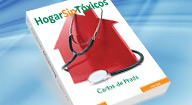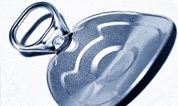Referencias científicas
- Hacia una estimación de la carga de morbilidad atribuible al medio ambiente. RESUMEN DE ORIENTACIÓN. AMBIENTES SALUDABLES Y PREVENCIÓN DE ENFERMEDADES. OMS 2006
Estrategia europea, de 11 de junio de 2003, en materia de medio ambiente y salud [COM (2003) 338 final – no publicada en el Diario Oficial]. http://europa.eu/legislation_summaries/public_health/health_determinants…
Comunicación de la Comisión, de 9 de junio de 2004, «Plan de acción europeo de medio ambiente y salud (2004-2010) [COM (2004) 416 – Diario Oficial C 49 de 28.2.2006]. http://europa.eu/legislation_summaries/public_health/health_determinants…
Comunicación de la Comisión, de 11 de junio de 2007, «Revisión Intermedia del Plan de Acción Europeo sobre Medio Ambiente y Salud 2004-2010» [COM (2007) 314 final – Diario Oficial C 191 de 17.8.2007]. http://eur-lex.europa.eu/smartapi/cgi/sga_doc?smartapi!celexplus!prod!Do…- BISPHENOL A SHOULD BE PHASED OUT FROM CONSUMER PRODUCTS . BEUC. 2011. http://www.beuc.org/BEUCNoFrame/Docs/1/BJHGFGCAJFONNFOIKDOBINONPDWY9DBYG…)
- BARÓMETRO DE MAYO. Estudio nº 2.888 . Mayo 2011. CIS http://www.cis.es/cis/export/sites/default/-Archivos/Marginales/2880_289…
- Ley 17/2011, de 5 de julio, de seguridad alimentaria y nutrición. BOLETÍN OFICIAL DEL ESTADO. Núm. 160 Miércoles 6 de julio de 2011
- En el apartado siete de su preámbulo establece que se intentará siempre que “que las decisiones que se adopten en materia de seguridad alimentaria se apoyen, siempre que sea posible, en el mejor y más actualizado conocimiento científico disponible”. En el capítulo preliminar, al hablar de los objetivos de la ley se establece “el derecho a conocer la incidencia de los riesgos emergentes en la seguridad alimentaria y a que las administraciones competentes garanticen la mayor protección posible frente a dichos riesgos” (Artículo 1, apartado 1). Añadiendo a continuación (art 2): “Son fines específicos de esta ley: a) El establecimiento de instrumentos que contribuyan a generar un alto nivel de seguridad de los alimentos y los piensos y la contribución a la prevención de los riesgos para la salud humana derivados del consumo de alimentos”
- COMUNICACIÓN DE LA COMISIÓN AL CONSEJO Y AL PARLAMENTO EUROPEO Estrategia comunitaria en materia de alteradores endocrinos (sustancias de las que se sospecha interfieren en los sistemas hormonales de seres humanos y animales. COM(1999)706 final. COMISIÓN DE LAS COMUNIDADES EUROPEAS. Bruselas, 17.12.1999.
- COMMISSION STAFF WORKING DOCUMENT on the implementation of the “Community Strategy for Endocrine Disrupters” – a range of substances suspected of interfering with the hormone systems of humans and wildlife (COM (1999) 706), (COM (2001) 262) (SEC (2004) 1372) and SEC(2007) 163
- COMMUNICATION FROM THE COMMISSION on the precautionary principle COMMISSION OF THE EUROPEAN COMMUNITIES Brussels, 02.02.2000. COM(2000) 1
- Bajo este reglamento se creó la Agencia Europea de Sustancias y Preparados Químicos, se modificó la Directiva 1999/45/ CE y se derogó el Reglamento (CEE) no 793/93 del Consejo y el Reglamento (CE) no 1488/94 de la Comisión, así como la Directiva 76/769/CEE del Consejo y las Directivas 91/155/CEE, 93/67/CEE, 93/105/CE y 2000/21/CE de la Comisión. Bruselas: Diario Oficial de la Unión Europea, 29.5.2007
- Community Rolling Action Plan (CoRAP), 29 February 2012. ECHA http://echa.europa.eu/documents/10162/13628/corap_2012_en.pdf
- The impacts of endocrine disrupters on wildlife, people and their environments. The Weybridge+15 (1996–2011) report. EEA Technical report. No 2/2012
- European Parliament resolution of 20 April 2012 on the review of the 6th Environment Action Programme and the setting of priorities for the 7th Environment Action Programme – A better environment for a better life (2011/2194(INI))
- The State of the Art Assestment of endocrine disruptors de diciembre de 2011. Final Report. Project Contract Number 070307/2009/550687/SER/D3.
EP Committee tells Commission “the sooner the better” on EDCs. Brussels, 23 January 2013
http://www.env-health.org/resources/press-releases/article/epcommittee-t…- Reprod Toxicol. 2007 Aug-Sep;24(2):131-8. Epub 2007 Jul 27. Chapel Hill bisphenol A expert panel consensus statement: integration of mechanisms, effects in animals and potential to impact human health at current levels of exposure. Vom Saal FS, Akingbemi BT, Belcher SM, Birnbaum LS, Crain DA, Eriksen M, Farabollini F, Guillette LJ Jr, Hauser R, Heindel JJ, Ho SM, Hunt PA, Iguchi T, Jobling S, Kanno J, Keri RA, Knudsen KE, Laufer H, LeBlanc GA, Marcus M, McLachlan JA, Myers JP, Nadal A, Newbold RR, Olea N, Prins GS, Richter CA, Rubin BS, Sonnenschein C, Soto AM, Talsness CE, Vandenbergh JG, Vandenberg LN, Walser-Kuntz DR, Watson CS, Welshons WV, Wetherill Y, Zoeller RT.
- Informe del Colectivo de Expertos. Solicitud de informes números: 2009-SA-0331 y 2010-0197-SA: Efectos sobre la salud del BPA. Septiembre 2011
Joint FAO/WHO Expert Meeting to Review Toxicological and Health Aspects of Bisphenol A
Summary Report including Report of Stakeholder Meeting on Bisphenol A. 1–5 November 2010
Ottawa, Canada- AMA supports tighter restrictions on products containing BPA. The move comes in the wake of numerous studies detailing the dangers of the organic compound. http://www.amaassn.org/amednews/2011/07/04/prsg0704.htm
3 Sep 2008: NTP Finalizes Report on Bisphenol A. NIEHS web: http://www.niehs.nih.gov/news/newsroom/releases/2008/september03/
NTP-CERHR Monograph on the Potential Human Reproductive and Developmental Effects of Bisphenol A. September 2008 NIH Publication No. 08–5994. Center for The Evaluation of Risks tTo Human Reproduction (CERHR)- National Toxicology Program (NTP)
Bisphenol A (BPA): Use in Food Contact Application. Update on Bisphenol A (BPA) for Use in Food Contact Applications. January 2010; Updated March 30, 2012 http://www.fda.gov/newsevents/publichealthfocus/ucm064437.htm
NTP-CERHR. (2007). NTP-CERHR EXPERT PANEL REPORT on the reproductive and developmental toxicity of bisphenol A. i-396. Report NTP-CERHR-BPA-07,
http://cerhr.niehs.nih.gov/chemicals/bisphenol/BPAFinalEPVF112607.pdf
Bisphenol A (BPA): Use in Food Contact Application. Update on Bisphenol A (BPA) for Use in Food Contact Applications. FDA. January 2010; Updated March 30, 2012
http://www.fda.gov/NewsEvents/PublicHealthFocus/ucm064437.htm- BISPHENOL A. An industrial chemical with adverse effects. Umweltbundesamt (German Federal Environment Agency). Updated version July 2010
REGLAMENTO DE EJECUCIÓN (UE) No 321/2011 DE LA COMISIÓN de 1 de abril de 2011 que modifica el Reglamento (UE) no 10/2011 por lo que respecta a la restricción del uso de bisfenol A en biberones de plástico para lactantes http://eur-lex.europa.eu/LexUriServ/LexUriServ.do?uri=OJ:L:2011:087:0001…
COMMISSION DIRECTIVE 2011/8/EU of 28 January 2011 amending Directive 2002/72/EC as regards the restriction of use of Bisphenol A in plastic infant feeding bottlesPress release of the Danish Ministry of Food, Fisheries and Agriculture: Danish ban on bisphenol A in materials in contact with food for children aged 0-3, 26.03.2010,
http://www.fvm.dk/News_display.aspx?ID=18488&PID=169628&year=’+thisYear+’&NewsID=6014- Bundesgesetzblatt Nr. BGBl. II Nr. 327/2011 Teil II. Datum der Kundmachung 06.10.2011 http://www.ris.bka.gv.at/Dokument.wxe?Abfrage=BgblAuth&Dokumentnummer=BG…
- Belgium aims to ban BPA in food containers for young children Wednesday, 18 January 2012 http://www.chemsec.org/news/news-2012/867-belgium-aims-to-ban-bpa-in-foo…
- Norwegian Pollution Control Authority. (2007). Impact assessment of a proposal for prohibition on certain hazardous substances in consumer pro¬ducts.
EFSA advises on safety of bisphenol A and confirms review of opinion in 2012. News Story
1 December 2011 http://www.efsa.europa.eu/en/press/news/111201.htm
Bisphenol A: EFSA launches full re-evaluation focussing on exposure and possible low dose effects.
News Story. 24 April 2012 http://www.efsa.europa.eu/en/press/news/120424.htm- Health Canada. (2008). News release 2008-167. Government of Canada Protects Families With Bisphenol A Regulations. http://www.hc-sc.gc.ca/ahc-asc/media/nrcp/_2008/2008_167-eng.php




